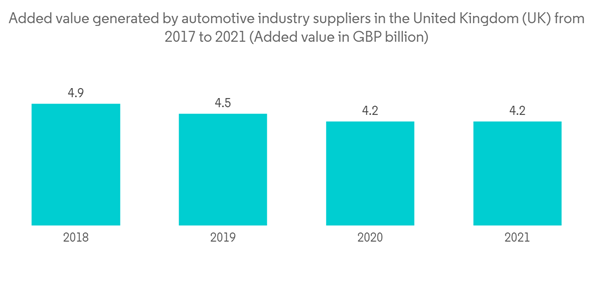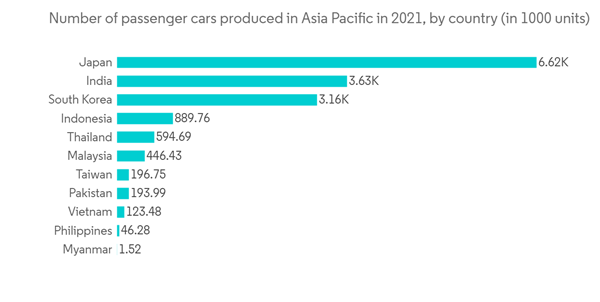Key Highlights
- The outbreak of the COVID-19 pandemic across the globe compelled car manufacturers to focus more on localizing their production. This was because the heavy dependence on a single region put them at high risk. China and Taiwan are the primary production hubs of semiconductors used in vehicles. Since the third quarter of 2020, the industry was facing shortages of raw materials, such as steel, and this was why OEMs were striving to surge the demand to replenish their inventories. This resulted in automakers' shift towards changing sourcing strategies, which, in turn, was believed to affect the automotive logistics industry.
- One of the critical reasons propelling the growth of the automotive third-party logistics market is the demand for these third-party logistics from the automotive sector to reduce inventory and supply chain expenses at each transaction along with their customers in the field. The need for the logistics provider is growing as the automotive industry seeks one-stop services for outsourcing services like inventory control, inbound material flow management, container management, kitting, packaging, cross-docking, reverse logistics, warehousing, transportation, and just-in-time delivery. The growth of e-commerce and new technologies impact the market for third-party automobile logistics.
- The need for expertise to handle complex supply chain activities like international documentation procedures and the growing emphasis on adaptability and responsiveness as a result of the modern supply chain becoming more customer-centric drive the growth of the automotive third-party logistics market. Additionally, the need for third-party automotive logistics is positively impacted by rising internet and mobile usage and an increase in the number of warehouses. Further, during the forecast period, the automotive third-party logistics market participants would benefit from changes in the retail business model and technological innovation.
- Asia Oceania is the largest market for domestic 3PL due to large-scale automobile production in China, Japan, and India. Domestic logistics include the services required to transport automotive vehicles and goods within a country and region. The automotive third-party logistics industry has grown substantially, particularly in emerging economies such as China and India. The area has witnessed growth in automotive production due to low wages, availability of raw materials, increased demand for vehicles, and the presence of major OEMs such as Toyota (Japan), Maruti Suzuki (India), and SAIC (China).
Automotive 3PL Market Trends
Increasing partnerships between automotive manufacturers and logistics companies
The automotive industry has been one of the prime contractors of logistics companies over the years, and the latter has benefitted massively from the automotive industry. The automotive industry continuously partners with logistics players to transport their components and finished vehicles from one location to another. With the increasing partnerships, automobile and component manufacturers are facilitated with better control in managing inbound and outbound transportation services, shorter lead times, and timely deliveries. The automobile industry relies heavily on outsourcing logistics services that aid in acquiring new information and expanding process flexibility.The automotive industry will likely pick up the pace soon after governments steadily lift the various containment measures to revive the economy. Automobile production gained pace in 2022. Over the last several years, 3PL industries have steadily given specialized services and IT solutions to the manufacturer's regions outside the business's primary focus. Outsourcing automobile logistics for parts sequencing or consolidation networks has shown to be a worthwhile investment.
Growth in Asia-Pacific automotive industry
The Asia-Pacific region, which spans a surface area of 29.3 million square kilometers, is home to 60% of the world's population. Numerous nations in the region, notably China and India, are in the top ten in terms of population growth. Asia's economies and sectors are continually changing, which is not surprising given the region's growing population.The automotive industry is one such sector. A growing population raises the need for efficient mobility. Some of the most valuable automakers in the world are said to be based in the area. With its high levels of production, the automotive industry-which encompasses the production of motor vehicles as well as aftermarket parts-generates significant sales of both passenger cars and commercial vehicles for the area. Because of this, it serves as the foundation of many Asia-Pacific economies.
The outbreak of the Coronavirus disease (COVID-19) acted as a massive restraint on the automotive parts and components market in 2020 as supply chains were disrupted due to trade restrictions and consumption declined due to lockdowns imposed by governments globally. However, Government incentives, growing regional demand, and easy availability of raw materials are expected to drive the market growth.
The development of the auto parts manufacturing industry in Asia- Pacific is primarily driven by the growing automobile manufacturing industry, especially in countries, such as China, Korea, and India. with the rising electric vehicle production, the requirement for a large and diversified number of automotive parts and components is increasing and this would be one of the major factors propelling the market growth in the region. Increasing scrapping rates of motor vehicles and engines tend to propel the demand for original equipment engines.
Scrap rates are higher in developed countries, owing to more stringent environmental regulations and thus, replacement of motor vehicles and their engines is more frequent compared to the developing world.
Automotive 3PL Industry Overview
The market is highly fragmented, with several large and small-sized companies. New players are entering the 3PL market with customized and industry-specific services. Some major players include CEVA Logistics, DB Schenker, and DHL. The 3PL players are willing to partner with other players to reduce cost and leverage on mutual competitive advantage. Hence, the market observes a high volume of partnerships, mergers, and acquisitions. The Asia-Pacific region has a high concentration of new and emerging players.Additional Benefits:
- The market estimate (ME) sheet in Excel format
- 3 months of analyst support
This product will be delivered within 2 business days.
Table of Contents
Companies Mentioned (Partial List)
A selection of companies mentioned in this report includes, but is not limited to:
- DB Schenker
- DHL Group
- DSV
- CEVA Logistics
- XPO Logistics
- Tiba Group
- GEFCO
- Kerry Logistics
- Nippon Express
- Hellmann Worldwide Logistics*










